
Saturday, August 12, 2006
Gotham Gets Its Very Own Star Map.
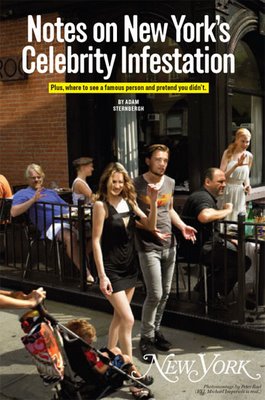
Well, now that West 27th Street in Chelsea has become Sunset Boulevard East, and since you're just as likely to spot a celeb at the Grey Dog Cafe as you are at the Urth Caffé (as Gawker.com's Gawker Stalker has been doing for a while now), the intrepid real-estate detectives at New York magazine have unveiled perhaps the most comprehensive -- and, according to the mag's editors, accurate -- star map for the Big Apple yet. (The image above, in case you were wondering, is a montage.)Using publicly available real-estate records, published reports, and, it says, "the occasional in-the-know friend or well-placed source," the magazine tracked down a huge trove of Gotham's stars' whereabouts -- and it just proves that packing 1.6 million people into a sliver of land 13 miles long and 2 miles wide makes for some interesting neighbors.Imagine, for instance, The Donald and Bruce Willis jostling each other on line at their local bagel joint in the morning on 56th street? Or Natalie Portman holding the door open for the quite-preggers Heidi Klum and hubby Seal at far West Village celeb-boite Perry St.? Or, perhaps, Ricky Martin, Jimmy Buffett, and Jay-Z all getting together in their Columbus Circle 'hood to confect a Latin-inflected rap-remake of "Margaritaville"? Hey, geographically speaking, it could happen. And what other insights into celeb real-estate can we glean from the map? The news people -- Barbara Walters, Tom Brokaw, Diane Sawyer, and Katie Couric -- all seem to live up on the patrician Upper East Side. (Don't worry -- Star and Barbara are separated by 15 blocks.) Famously combustible divas Diana Ross and Naomi Campbell live within just a couple blocks of each other in the Fifties in Midtown; good thing PBS' Charlie Rose is around to calm 'em down. The cool kids -- like Chloë Sevigny, director Wes Anderson, the Strokes' Julian Casablancas, and David Blaine -- live near each other in the nebulous East Village-y, NYU, south-of-Union Square district. Then there's the outright weird Upper West Side block that houses Moby, Garrison Keillor, Faye Dunaway, and Ron Howard.And, finally, we learn that the twelve-block swath through the middle of town from about 24th Street to 36th Street is a pretty celeb-free zone -- unless, of course, you count Gilbert Gottfried as a celebrity.
Five Minutes With: Lee Daniels
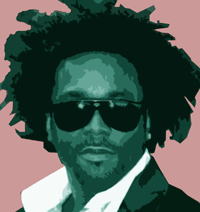
Lee Daniels’ films challenge boundaries: that between black and white, sex and violence, tragedy and love. As the producer of “Monster’s Ball,” Daniels brought to the big screen a story of racism, the death penalty, and romance in the rural South. Halle Berry became the first African-American woman ever to win a best actress Oscar for her starring role in the film. Now Daniels has stepped behind the camera as director of “Shadowboxer,” a surreal hit man film built around an interracial, quasi-incestuous relationship between Cuba Gooding, Jr. and Dame Helen Mirren. The premise might seem bizarre, but “Shadowboxer,” through scenes of unflinching violence and beauty, casts a powerful spell. Daniels talked with Campus Progress about sex scenes, racial politics, and the understated gay aesthetic of his films.
Interracial romance is a theme in your work. What attracts you to such stories?
With all my films, I have a tendency to cast colorblind, and this movie, it was cast colorblind. It just so happened that it was interracial. Originally it was Diana Ross [playing the role of Rose], and then Helen Mirren stepped in. I mean, I just find the best actor for the role. Now that might have something to do with the fact that I’m black and I’m a filmmaker, and I always try to give everybody of color a chance. But I give the best actor available the job, because in life, everybody is mixed up with everybody, and it’s not cookie cutter the way Hollywood pretends it to be.
I remember reading that there was controversy over you casting Mo’Nique in her role, since the character of Precious was originally intended to be an anorexic white woman, not a plus-sized black woman. The screenwriter was very angry about that choice and withdrew his name from the project. Was that another instance of you casting colorblind?
It was just a case of “may the best actor get the job.”
In both “Monster’s Ball” and in “Shadowboxer,” there seems to be a theme of using sex to represent escape and redemption. There’s something about your sex scenes that seem so raw and real, because they’re not what we’re used to seeing on the screen. How do you coax those performances out of your actors, and is it really challenging?
Again, I try to project as much honesty as I can on sex scenes, because I think that sex is an integral part of human nature, and there’s nothing to be ashamed about. And I think that we have a tendency—not that I want to be in your face, and I don’t really want to see pornography—but I think that we need to understand the connection between human suffering and sex, and that sex isn’t just sex for pleasure.
In the theater that I saw the film in, there was a lot of sort of giggling or even comments about the age difference between Mikey and Rose.
Really? Like in a bad way?
People were like, “Get it on, Grandma!” and stuff like that.
I heard that too! People were like, “Go Grannie, go grannie!” I didn’t know what to make of that. Am I gonna be offended by this? How do I take that?
I had the opposite reaction. Going into it, I thought I was going to feel weird about the age difference, but then Helen Mirren was very sexy in the role. So I was wondering if you could talk about the reactions you’re hearing.
Well, what I’m hearing is all over the place. You know, some people love it, some people hate it. But that’s been with my movies all across the board. Some people loathe it. And when they loathe it, they go on and on about it, and then I know that I’ve struck a chord. They could just say, “Oh, this is terrible.” But they go into into detail, and then they go for the jugular. And I remember calling my friend Lenny Kravitz, because I’m working with him, and saying, “Why are people either adulating over this film or they’re like going for the jugular?” And he said, “It’s because you evoked something.” There’s no gray area. There’s no, “Oh, this is okay.” You walk away thinking about the film. It evokes an emotion. And I think that’s what cinema is about—good cinema. You walk away thinking, “God dang it, why’d I pay good money for this, I hated it. Can you believe he had the nerve?!” Or you go, “Oh wow.”
“Shadowboxer” is less explicitly political than “Monster’s Ball,” which dealt with the intersection of racial and sexual politics in the rural south. But in “Shadowboxer,” the character of Rose comes from this radical activist background, and turns to crime when she becomes frustrated by her inability to make the world a better place.
All of the characters that I have in all of my films are people that I understand, and know, and identify with. So these are all people that I personally know. Personally. There was a lady that lived around the corner from me when I was growing up, she was a Black Panther—I grew up in the sixties and the seventies. And she was a great lady and through a series of events, her life just twirled out [of control]. I called her my black Patty Hearst, because she really got caught up and before you know it, she killed a couple of people. She started out from a really great place and through a series of events, she got strung out. So, of course, Helen Mirren is white. I’m black, and I sort of took creative liberty.
You’re a gay filmmaker, but we haven’t really seen any gay characters in your films. Do you think those are stories you’re going to want to bring to the screen in future projects?
Actually, I was one of the producers on “ Brokeback Mountain.” It ended up that I couldn’t get the movie made, so I didn’t produce the movie. But it was with me for awhile. I do feel that there is a gay sensibility in all of my films. There’s something in there. You’ve got a little bit of “Valley of the Dolls,” especially this one I directed, you see more of a taste, I should say, that there is an affinity toward men’s asses and penises—if you look closely.
Beyonce's Exclusive Eavesdrop: Never Before Heard Excerpts of Her Much-Talked about Interview in the August-September 2006 Issue of GIANT Magazine.

her... Her mannerisms, her grace...she is fierce."
One would think that GIANT Magazine's current iconic cover featuring a multi-platinum beauty carefree in curlers would be enough to satisfy its editors. But, GIANT Magazine is all about thinking big. In an unprecedented move to connect readers with their heroes, GIANT Magazine has secured the permission of Beyonce Knowles to release private audio from the phenom's one-on-one interview with editorial director Scott Polson-Bryant. The ultimate entertainment publication shatters the barriers of traditional publishing with an exclusive podcast featuring unpublished portions of Beyonce's revealing interview.
Available simultaneously on Giantmag.com, iTunes and BeyonceOnline.com on August 7, 2006, the seven-part podcast features Beyonce in her own words and her own voice. Nothing stands between the megastar and her fans as she emotionally explains why she would have taken the part in "Dreamgirls" for free, reveals the intimate details about the secret recording of her new album, "B-Day," laughs playfully about the parody of her on "Saturday Night Live" and how her alter-ego, Sasha, "grabbed the mic" from Prince on stage. Hear Beyonce also speak on Diana Ross, and her last conversation with the late Luther Vandross.
"In our current issue of GIANT, Beyonce proves she's one of the most beautiful women in the world. She's half-dressed, wearing curlers, and still looks absolutely stunning," explains GIANT's new Editor-in-Chief Smokey D. Fontaine about his first issue. "Now, she has gone a step further by granting approval for our landmark podcast. This was not planned at the time of the interview. However, after observing her fearlessness during the photo shoot and her forthright attitude, we approached her with a brand-new idea and she agreed. With this groundbreaking event, Beyonce truly bridges the gap between celebrity and consumer. The woman is an undisputed trailblazer - someone we will talk about for decades to come."
The never-before-heard podcasts of the unpublished GIANT interview will be released by GIANT Magazine every other day through August 21, 2006.
'The Wiz' to be shown at library.

The Anderson County Library continues its monthly Film Night at 7 p.m. Aug. 18 with the film version of the classic Broadway musical "The Wiz."
The G-rated film, directed by Sidney Lumet, features Diana Ross as a kindergarten teacher in New York City’s Harlem. Caught up in a cyclone, she’s swept to the Land of Oz, which looks a lot like Manhattan. On her trip to meet the Wizard (Richard Pryor), she’s joined by the Scarecrow (Michael Jackson), the Tin Man (Nipsy Russell) and the Cowardly Lion (Ted Ross).
The presentation will be at the Main Library, 300 N. McDuffie St., Anderson. Popcorn, candy and soda will be available for purchase, with proceeds going to the Friends of the Library.
For more information, contact Marybeth Evans, community services coordinator, at (864) 260-4500, ext. 107.
Diana Ross to Tour Australia

Ross, whose hits both with The Supremes and solo include ‘Ain’t No Mountain High Enough’, ‘Stop! In The Name Of Love’ and ‘Upside Down’ just to name a few, will be playing in Australia.
She will be the special guest at the Melbourne Cup Carnival Chairman’s dinner, an event which costs hundreds of dollars if you are lucky enough to have a ticket made available to you. Last year the musical guest was Luciano Pavarotti.
Those of you without a wad of fifties falling out of your pocket every time you raise your arm and click your fingers so Bigglesworth can get you another glass of port* can check her out at her other dates.
October 31 - The Regent, MelbourneNovember 1 – Melbourne Cup Carnival Chairman’s Dinner, MelbourneNovember 3 – Sydney, Capitol TheatreNovember 4 – Sanctuary Cove, Queensland (venue TBC)
Tickets are on sale 9am, Thursday August 10.
Diana Ross coming to carnival
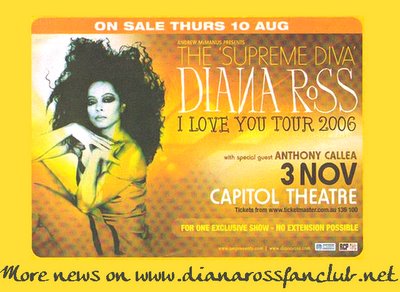
MOTOWN singer Diana Ross will be the entertainment at a $1150-a-head dinner during this year's Melbourne Spring Racing Carnival.A limited number of public tickets will be sold for the annual Victoria Racing Club's Chairman's Dinner on November 1.
The Supremes' star is the second big entertainer VRC has lured for the black-tie event. Tenor Luciano Pavarotti performed last year.
Chairman's Dinner tickets go on sale through the VRC on August 10.
Going Back to His Roots.

With the possible exception of Dame Edna Everage, RuPaul is the most famous drag queen in the world.
A fixture on the US gay circuit through the 1980s, RuPaul achieved international success in 1993 with the release of his debut album, Supermodel of the World, featuring global smash hit ‘Supermodel (You Better Work)’. He’s since recorded a further five albums; released a duet with Elton John; secured a contract as the face of MAC Cosmetics; hosted a popular US talk show, The RuPaul Show; and made his mark on Hollywood, filming several mainstream roles (most famously Jan Brady’s guidance counsellor in the Brady Bunch movies) and a slew of independent parts.
But if he was trying to “make it” in 2006 instead of the early ’90s, RuPaul, who’s just released a new album, ReWorked, reckons he wouldn’t stand a chance.
“When I released Supermodel of the World, there was a window of opportunity in this country that allowed that to happen. And it’s definitely closed at this point,” the performer tells SX from his East Village, Manhattan apartment.
“There’s this new spirit towards men who use femininity as a palette and it’s really, unfortunately, the strongest in the gay community. The gay community today is obsessed with ‘straight acting’, with appearing to be, quote-unquote, ‘normal’. I guess they’re thinking that conservative, right-wing religious people will think, ‘Oh, they’re fine – they’re just like us! Give them the right to marry!’ I think that’s the wrong approach. I think we have to embrace everything about ourselves: femme, butch, whatever.”
Partly to blame, says RuPaul, is yours truly. Well, not me personally, but gay journalists and the gay media as a whole, who the performer says are generally shirking community responsibilities.
“There are several amazing, wonderful queer artists right now – Lady Bunny, Ari Gold, Adam Joseph – but they don’t get the exposure they should get. I believe the gay news media should foster and encourage gay culture, but gay magazines around the world, especially here in the United States, usually put straight people on the cover. You know, Essence magazine, which is a black women’s magazine over here, would never have Britney Spears on the cover, because there’d be an outcry. But gay culture chases after straight people.”
RuPaul opines that a collective “self-loathing” is at the core of the problem and, somewhat surprisingly for a drag performer, he points to the gay community’s “diva worship” as an example.
“The gay community’s worship of female pop stars ... well, I love it, and I’ve been a part of it. My generation, we loved Diana Ross and Cher, and I’m a big fan of Kylie. But I think there’s also an aspect of self-loathing in there. I haven’t quite figured out how it angles in there, but I definitely get a sense of it. I think that it’s tied into the gay obsession with straight culture, because in this country at least, it’s very rare for the gay community to really go gung-ho and support our own.”
This isn’t something I expected to hear from a man who has ‘glamorous pop diva’ down pat, but anyone fearing that the drag star has become serious and staid, fear not. A few minutes later, speaking about Australia, Ru (as he likes to be called) launches into an Aussie accent, raucously quoting his favourite lines from the Stephan Elliot comedy Welcome to Woop Woop, his “very favourite” film.
As we all know, Americans just can’t do Australian accents; even that queen of accents, Meryl Streep, didn’t quite get there as Lindy Chamberlain in Evil Angels. But RuPaul as an Aussie sounds 100 per cent, dead-set dinky-di; completely indistinguishable from someone born and bred here.
“I’m a huge Aussie-phile,” he explains, laughing at my incredulity. “I’m obsessed with your country. In fact, I was in a relationship with an Aussie for six years. We’re not together anymore, but we speak on the phone every day and we’re still family. We often talk about packing up and going there.
“Mathu Anderson, who’s always done my hair and make-up, is also Australian,” he continues. (Anderson took the photo that graces this week’s cover.) “And I’ve just always had Australians in my life. I’d really love to go back soon, because it’s been a few years now.”
Before that happens, RuPaul has a few other projects to complete: US promotion for his new album ReWorked (a collection of his singles, remixed); completing Starbooty: Reloaded, a movie he wrote, produced and stars in; and adding a new bow to his list of achievements – porn movie director.
“You’re going to be the new Chi-Chi LaRue?” I ask.
“Sure am, honey,” he replies. “Actually, I’ve been a friend of Chi-Chi’s for about 17 years and I just called her yesterday to ask what kind of deal I should ask for from this company. I can’t say anything more about it, but I can’t wait to direct my first full-length porn feature. You know, it’s so hot that in my lifetime I’ve been able to do all of these different things, and now adding ‘porn director’ to my résumé is just, well, I think it’s just fabulous!”
RuPaul’s new album ReWorked is out now.
www.rupaul.com
Sisters are doing it for themselves
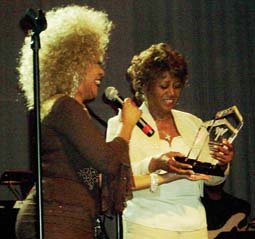
Former Ladies of the Supremes reunite in Los Angeles
Published 08/10/2006
The much-anticipated 20th Anniversary Celebration of the Former Ladies of the Supremes took place at the Music Box at the Henry Fonda Theatre in Hollywood on the evening of Saturday, July 29.
Scherrie Payne's powerful lead on the 1970 proto-disco mega-hit "Stoned Love" surpassed even Jean Terrell's original lead vocal. Lynda Lawrence pulled the enthusiastic, mostly middle-aged audience in, leading them sing-along-style on the infectious chorus.
The Ladies veered off-course on at least one occasion. Scherrie and Lynda left Freddie Poole onstage for a raucous solo on Aretha Franklin's signature song, "Respect." Freddie got the crowd worked up and dancing in the aisles. But I think a more fitting song considering the event would have been the 1971 Jean Terrell-led Supremes gold record "Nathan Jones."
The format, equal time for each lady, worked against the overall cohesion of the group. Scherrie Payne, known as "the little lady with the big voice," is the major talent in the current line-up, and should handle at least 50% of the leads. Her incredible solo on a little-known song she wrote, "Another Lifetime from Now," electrified the house.
The image of a selfish diva way out in front, hogging the spotlight, attention and bucks, may have taken a licking in the past few years, but it still works for me. If a woman has the talent to pull it off, I say go for it!
Freddie Poole took the lead on "You Can't Hurry Love," and she did an admirable job, but no blue ribbon. Her delivery was nowhere near as smooth as Diana's silky lead, and her phrasing was choppy at best.
Al three ladies shared the lead on their bouncy new single "Sisters United," which they debuted. The emotional highlight of the night was when the trio honored the Supremes who came before them. Diana Ross could not attend due to a scheduling conflict, and Jean Terrell was also a no-show. Florence Ballard died tragically in the mid-70s.
Tribute offer Lynda offered a beautiful tribute to the Supreme she replaced in late 1971, Cindy Birdsong, who Lynda said taught her everything she knows. With that warm introduction, a now very slim Birdsong, who replaced founding member Florence Ballard in 1967 when the group was renamed Diana Ross and the Supremes, took the stage to sing a song she penned for the evening, in tribute to all eight ladies of the Supremes.
Payne, who replaced Jean Terrell as lead singer in 1973, went on to honor the recently ailing Mary Wilson. She said the original Supreme was invited, but her lawyer declined on her behalf, which brought a tremendous roar from the heavily gay audience.
Wilson sued the Former Ladies of the Supremes for trademark infringement. Wilson claimed they had no right to use the name Supremes in any form. Ironically, the court ruled against her, stating, in essence, that the Supremes are whoever Motown says they are.
These animosities and deep personal wounds were always just under the glamorous, sequined surface of the concert. But Birdsong put it best when she said they were all sisters. All the ladies who were at one time members of the group share in the legacy, memories and glory of being a Supreme.
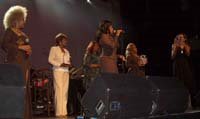
"It was the best, the very best part of my life, being in the Supremes. I thank Mary Wilson, Diana Ross, and Berry Gordy for that opportunity, I thank all the ladies who shared that experience with me, including my predecessor Florence Ballard, and all the fans that have sustained us over the many years," a teary-eyed Birdsong said as the three-hour program concluded.
Some of the original studio recordings by the Former Ladies of the Supremes hold their own against any era of the Supremes. My favorites include the very 60s-ish "Too Many Memories" and "Crazy Bout the Guy," and the three-lead-vocal remake of "Stoned Love" featuring Scherrie Payne, Lynda Lawrence and Jean Terrell.
I should be ashamed to admit that I didn't even know who Gloria Loring, the opening act, was. I was fully prepared to hate her. To my surprise, she delivered a powerful half-hour warm-up that was thoroughly enjoyable. I soon learned that she was on Days of Our Lives for six and a half years, but is perhaps better known today as a singer/songwriter. She went on to tell us she wrote the theme song for the long-running Diff'rent Strokes TV sitcom.
Loring also sang her original theme song from The Facts of Life. "Yep, that's my voice you've been listening to all these years," she said as she launched into the catchy tune. She struggled to force a comparison between herself and the headliners that evening, but she really had no more connection to the Supremes than anyone else who grew up in the 1960s and 70s. She loved the Motown sound, of which the Supremes were the most successful proponents.